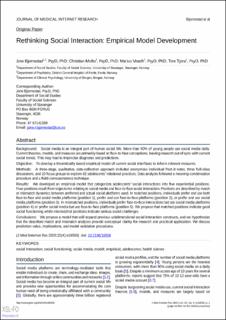| dc.contributor.author | Bjørnestad, Jone Ravndal | |
| dc.contributor.author | Moltu, Christian | |
| dc.contributor.author | Veseth, Marius | |
| dc.contributor.author | Tjora, Tore | |
| dc.date.accessioned | 2023-02-08T08:11:41Z | |
| dc.date.available | 2023-02-08T08:11:41Z | |
| dc.date.created | 2020-07-05T22:28:20Z | |
| dc.date.issued | 2020 | |
| dc.identifier.citation | Bjornestad, J., Moltu, C., Veseth, M., & Tjora, T. (2020). Rethinking social interaction: Empirical model development. Journal of Medical Internet Research, 22(4), e18558. | en_US |
| dc.identifier.issn | 1438-8871 | |
| dc.identifier.uri | https://hdl.handle.net/11250/3049093 | |
| dc.description.abstract | Background:
Social media is an integral part of human social life. More than 90% of young people use social media daily. Current theories, models, and measures are primarily based on face-to-face conceptions, leaving research out of sync with current social trends. This may lead to imprecise diagnoses and predictions.
Objective:
To develop a theoretically based empirical model of current social interfaces to inform relevant measures.
Methods:
A three-stage, qualitative, data-collection approach included anonymous individual Post-it notes, three full-class discussions, and 10 focus groups to explore 82 adolescents’ relational practices. Data analysis followed a meaning-condensation procedure and a field-correspondence technique.
Results:
We developed an empirical model that categorizes adolescents’ social interactions into five experiential positions. Four positions result from trajectories relating to social media and face-to-face social interaction. Positions are described by match or mismatch dynamics between preferred and actual social platforms used. In matched positions, individuals prefer and use both face-to-face and social media platforms (position 1), prefer and use face-to-face platforms (position 2), or prefer and use social media platforms (position 3). In mismatched positions, individuals prefer face-to-face interactions but use social media platforms (position 4) or prefer social media but use face-to-face platforms (position 5). We propose that matched positions indicate good social functioning while mismatched positions indicate serious social challenges.
Conclusions:
We propose a model that will expand previous unidimensional social interaction constructs, and we hypothesize that the described match and mismatch analyses provide conceptual clarity for research and practical application. We discuss prediction value, implications, and model validation procedures. | en_US |
| dc.language.iso | eng | en_US |
| dc.publisher | JMIR Publications | en_US |
| dc.rights | Navngivelse 4.0 Internasjonal | * |
| dc.rights.uri | http://creativecommons.org/licenses/by/4.0/deed.no | * |
| dc.title | Rethinking Social Interaction: Empirical Model Development | en_US |
| dc.type | Peer reviewed | en_US |
| dc.type | Journal article | en_US |
| dc.description.version | publishedVersion | en_US |
| dc.rights.holder | The authors | en_US |
| dc.subject.nsi | VDP::Samfunnsvitenskap: 200 | en_US |
| dc.source.pagenumber | 15 | en_US |
| dc.source.volume | 20 | en_US |
| dc.source.journal | Journal of Medical Internet Research | en_US |
| dc.source.issue | 4 | en_US |
| dc.identifier.doi | 10.2196/18558 | |
| dc.identifier.cristin | 1818623 | |
| cristin.ispublished | true | |
| cristin.fulltext | original | |
| cristin.qualitycode | 2 | |

